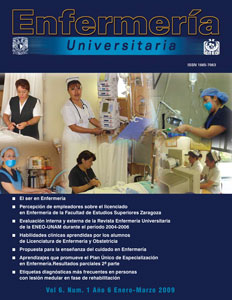Habilidades clínicas aprendidas por los alumnos de la Licenciatura en Enfermería y Obstetricia en fundamentos de Enfermería en la ENEO-UNAM
Main Article Content
Abstract
Introduction; WHO´S priority programs on patient safety seek promote optimal nursing practices and therefore reduce risks on patients, Performed mainly by nurses, affiliated countries have incorporated such programs in to their strategic health plans. Following our graduates up we explore their perceptions on the quality of health care in order to feedback and improve our teaching programs. Methodology: This is a descriptive study with a random sample of 58 graduates. The instrument includes variables of general character, academic background, professional performance, working status, and options related to security and integral care. It is applied by direct interview. Dates are analyzed with descriptive and inferential statistical techniques. Results: Graduates identify integral health care with patient security which, among others procedures, is reflected by correct medicine prescription and fall/ pressure sores absence. Coincident with “CIE” declarations, they also highlight the impact of work overload and hospital materials scarcity on error events. Conclusions: Findings support the relevance of such priority programs, and therefore the importance of nursing schools and their graduates, in the achievement of WHO´S goals on patient security
Publication Facts
Reviewer profiles N/A
Author statements
- Academic society
- N/A
- Publisher
- Universidad Nacional Autónoma de México
Article Details
Dimensions citation
MÉTRICAS
Enfermería Universitaria by Universidad Nacional Autónoma de México it is distributed under the License Creative Commons Attribution - NonCommercial - NoDerivatives 4.0 International
Accepted and published articles become open-access under the terms of the Creative Commons CC BY-NC-ND 4.0 license, which authorizes the reproduction and sharing without commercial purposes, provided the corresponding acknowledgments to their authors. Authors are allowed to manage a self-archive copy of the article’s published version so that they can open-access it in their personal or institutional web pages, and/or any other broad-diffusion space.


